The Application of Chain Game Simulations in Global Economy Analysis
VerifiedAdded on 2022/11/17
|7
|1325
|61
Report
AI Summary
This report examines the application of a chain game simulation as a tool to understand and analyze real-world global economic conditions. The simulation allows managers and students to develop and assess various supply chain strategies, make informed decisions, and understand their impact on overall profitability. The paper discusses the use of the chain game in planning exports and imports, managing demand and supply, and allocating resources effectively. It outlines five key conditions of the global economy that are reflected in the simulation: planning, manufacturing, delivery and logistics, sourcing, and return systems. The report also describes the mechanics of the simulation, including the roles of instructors and players, the use of dashboards and models, and the importance of data analysis to assess performance. The chain game simulation helps students familiarize themselves with supply chain processes, plan strategies, and adapt to challenging situations, providing a practical learning experience to enhance their understanding of business operations and the global economy.
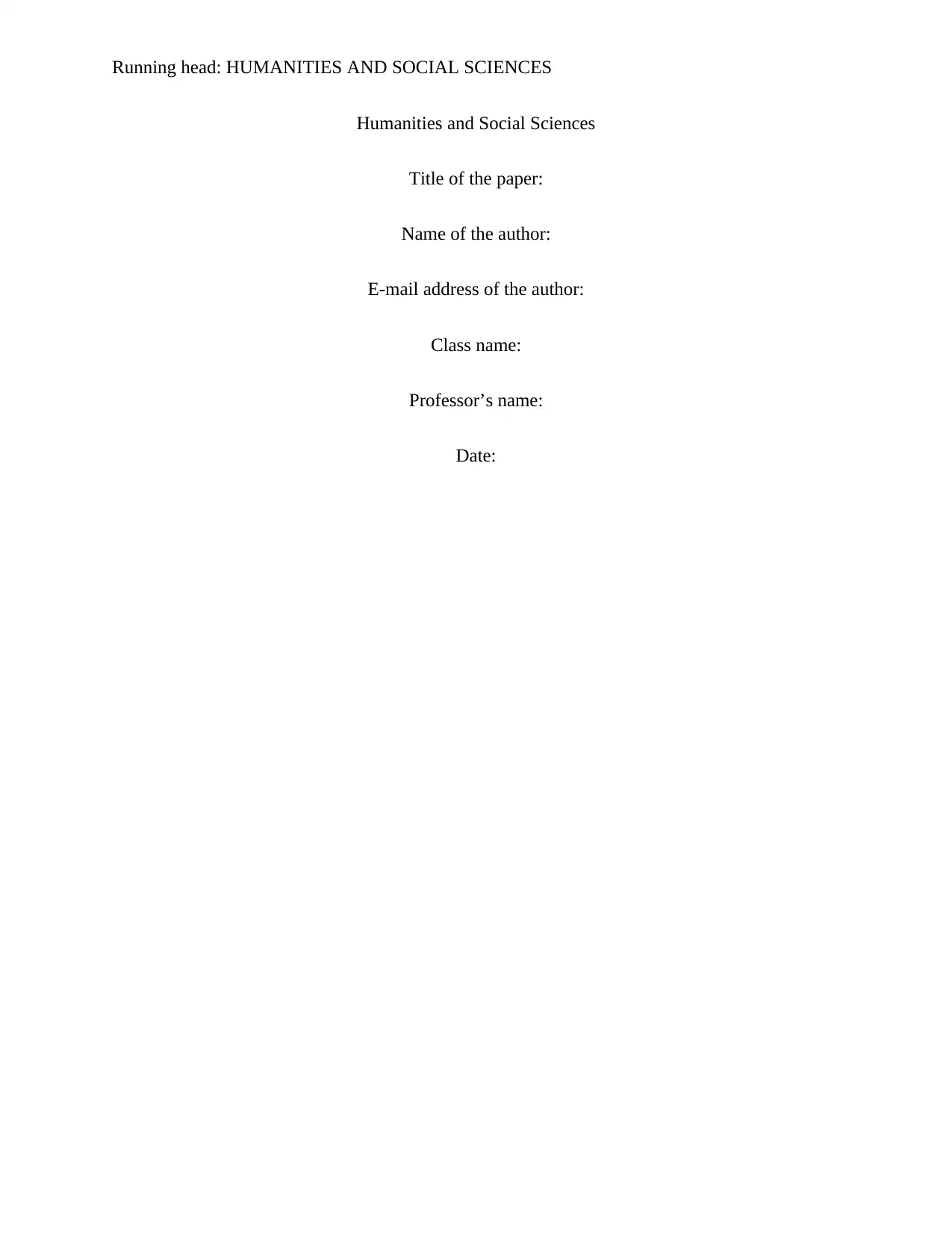
Running head: HUMANITIES AND SOCIAL SCIENCES
Humanities and Social Sciences
Title of the paper:
Name of the author:
E-mail address of the author:
Class name:
Professor’s name:
Date:
Humanities and Social Sciences
Title of the paper:
Name of the author:
E-mail address of the author:
Class name:
Professor’s name:
Date:
Paraphrase This Document
Need a fresh take? Get an instant paraphrase of this document with our AI Paraphraser
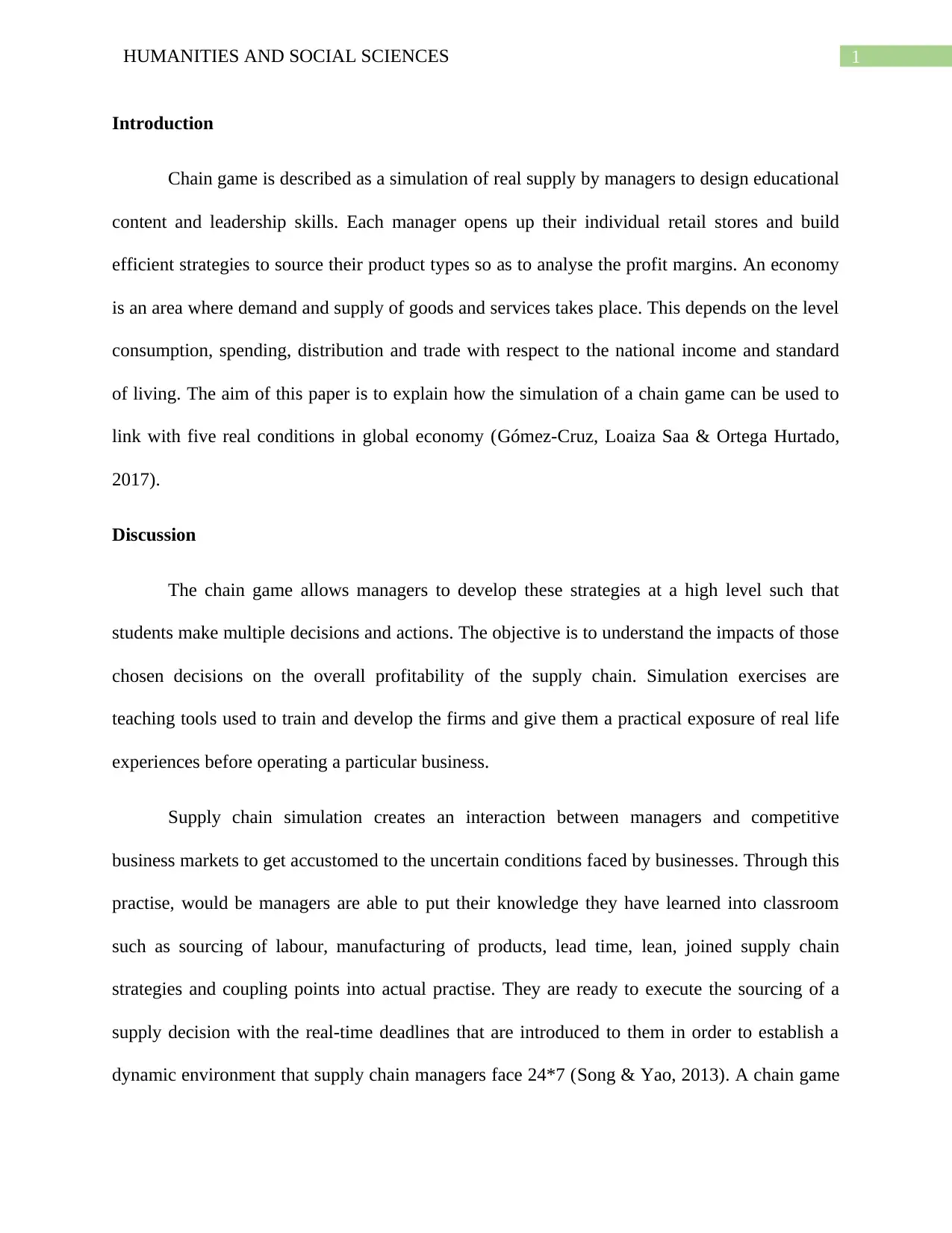
1HUMANITIES AND SOCIAL SCIENCES
Introduction
Chain game is described as a simulation of real supply by managers to design educational
content and leadership skills. Each manager opens up their individual retail stores and build
efficient strategies to source their product types so as to analyse the profit margins. An economy
is an area where demand and supply of goods and services takes place. This depends on the level
consumption, spending, distribution and trade with respect to the national income and standard
of living. The aim of this paper is to explain how the simulation of a chain game can be used to
link with five real conditions in global economy (Gómez-Cruz, Loaiza Saa & Ortega Hurtado,
2017).
Discussion
The chain game allows managers to develop these strategies at a high level such that
students make multiple decisions and actions. The objective is to understand the impacts of those
chosen decisions on the overall profitability of the supply chain. Simulation exercises are
teaching tools used to train and develop the firms and give them a practical exposure of real life
experiences before operating a particular business.
Supply chain simulation creates an interaction between managers and competitive
business markets to get accustomed to the uncertain conditions faced by businesses. Through this
practise, would be managers are able to put their knowledge they have learned into classroom
such as sourcing of labour, manufacturing of products, lead time, lean, joined supply chain
strategies and coupling points into actual practise. They are ready to execute the sourcing of a
supply decision with the real-time deadlines that are introduced to them in order to establish a
dynamic environment that supply chain managers face 24*7 (Song & Yao, 2013). A chain game
Introduction
Chain game is described as a simulation of real supply by managers to design educational
content and leadership skills. Each manager opens up their individual retail stores and build
efficient strategies to source their product types so as to analyse the profit margins. An economy
is an area where demand and supply of goods and services takes place. This depends on the level
consumption, spending, distribution and trade with respect to the national income and standard
of living. The aim of this paper is to explain how the simulation of a chain game can be used to
link with five real conditions in global economy (Gómez-Cruz, Loaiza Saa & Ortega Hurtado,
2017).
Discussion
The chain game allows managers to develop these strategies at a high level such that
students make multiple decisions and actions. The objective is to understand the impacts of those
chosen decisions on the overall profitability of the supply chain. Simulation exercises are
teaching tools used to train and develop the firms and give them a practical exposure of real life
experiences before operating a particular business.
Supply chain simulation creates an interaction between managers and competitive
business markets to get accustomed to the uncertain conditions faced by businesses. Through this
practise, would be managers are able to put their knowledge they have learned into classroom
such as sourcing of labour, manufacturing of products, lead time, lean, joined supply chain
strategies and coupling points into actual practise. They are ready to execute the sourcing of a
supply decision with the real-time deadlines that are introduced to them in order to establish a
dynamic environment that supply chain managers face 24*7 (Song & Yao, 2013). A chain game
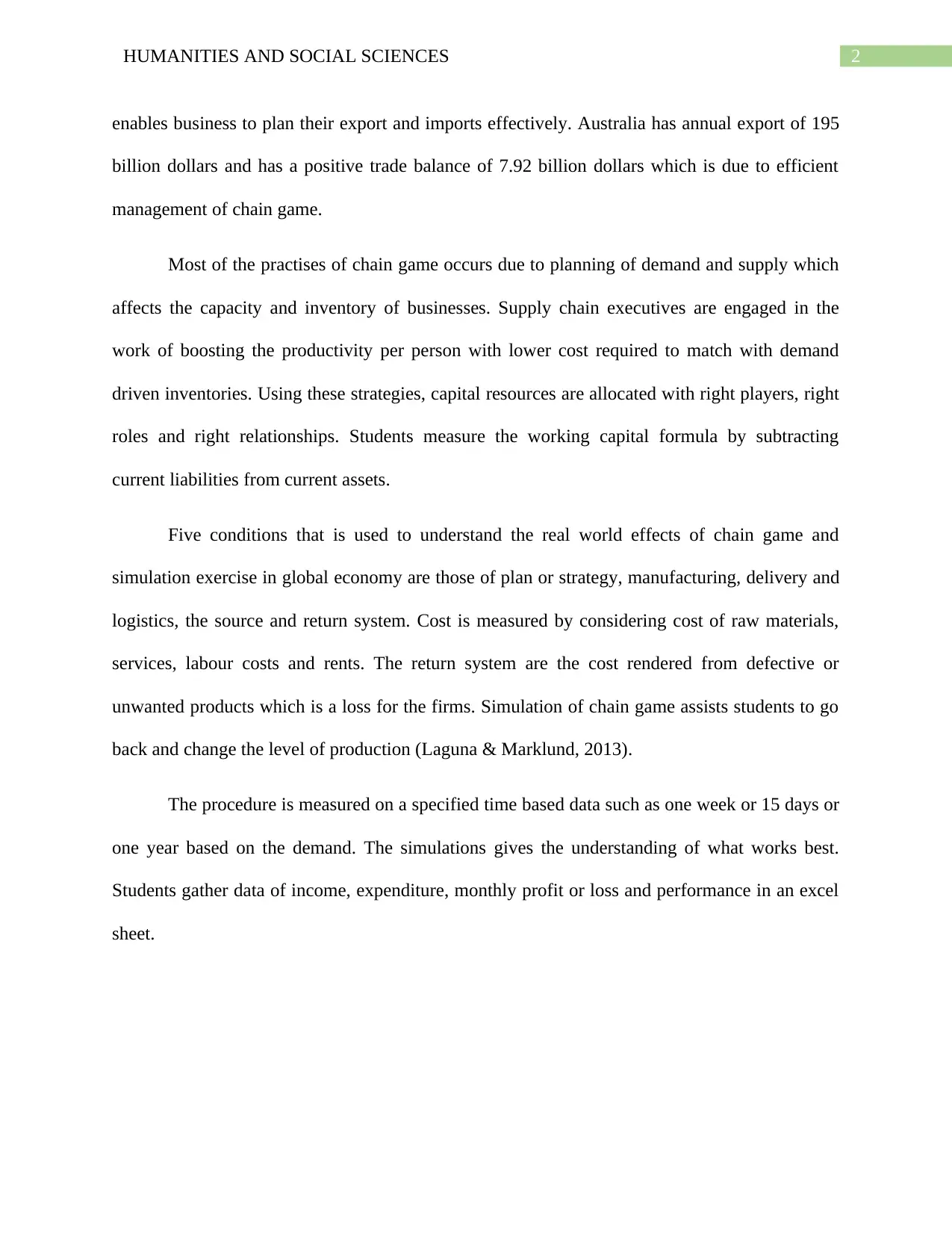
2HUMANITIES AND SOCIAL SCIENCES
enables business to plan their export and imports effectively. Australia has annual export of 195
billion dollars and has a positive trade balance of 7.92 billion dollars which is due to efficient
management of chain game.
Most of the practises of chain game occurs due to planning of demand and supply which
affects the capacity and inventory of businesses. Supply chain executives are engaged in the
work of boosting the productivity per person with lower cost required to match with demand
driven inventories. Using these strategies, capital resources are allocated with right players, right
roles and right relationships. Students measure the working capital formula by subtracting
current liabilities from current assets.
Five conditions that is used to understand the real world effects of chain game and
simulation exercise in global economy are those of plan or strategy, manufacturing, delivery and
logistics, the source and return system. Cost is measured by considering cost of raw materials,
services, labour costs and rents. The return system are the cost rendered from defective or
unwanted products which is a loss for the firms. Simulation of chain game assists students to go
back and change the level of production (Laguna & Marklund, 2013).
The procedure is measured on a specified time based data such as one week or 15 days or
one year based on the demand. The simulations gives the understanding of what works best.
Students gather data of income, expenditure, monthly profit or loss and performance in an excel
sheet.
enables business to plan their export and imports effectively. Australia has annual export of 195
billion dollars and has a positive trade balance of 7.92 billion dollars which is due to efficient
management of chain game.
Most of the practises of chain game occurs due to planning of demand and supply which
affects the capacity and inventory of businesses. Supply chain executives are engaged in the
work of boosting the productivity per person with lower cost required to match with demand
driven inventories. Using these strategies, capital resources are allocated with right players, right
roles and right relationships. Students measure the working capital formula by subtracting
current liabilities from current assets.
Five conditions that is used to understand the real world effects of chain game and
simulation exercise in global economy are those of plan or strategy, manufacturing, delivery and
logistics, the source and return system. Cost is measured by considering cost of raw materials,
services, labour costs and rents. The return system are the cost rendered from defective or
unwanted products which is a loss for the firms. Simulation of chain game assists students to go
back and change the level of production (Laguna & Marklund, 2013).
The procedure is measured on a specified time based data such as one week or 15 days or
one year based on the demand. The simulations gives the understanding of what works best.
Students gather data of income, expenditure, monthly profit or loss and performance in an excel
sheet.
⊘ This is a preview!⊘
Do you want full access?
Subscribe today to unlock all pages.

Trusted by 1+ million students worldwide
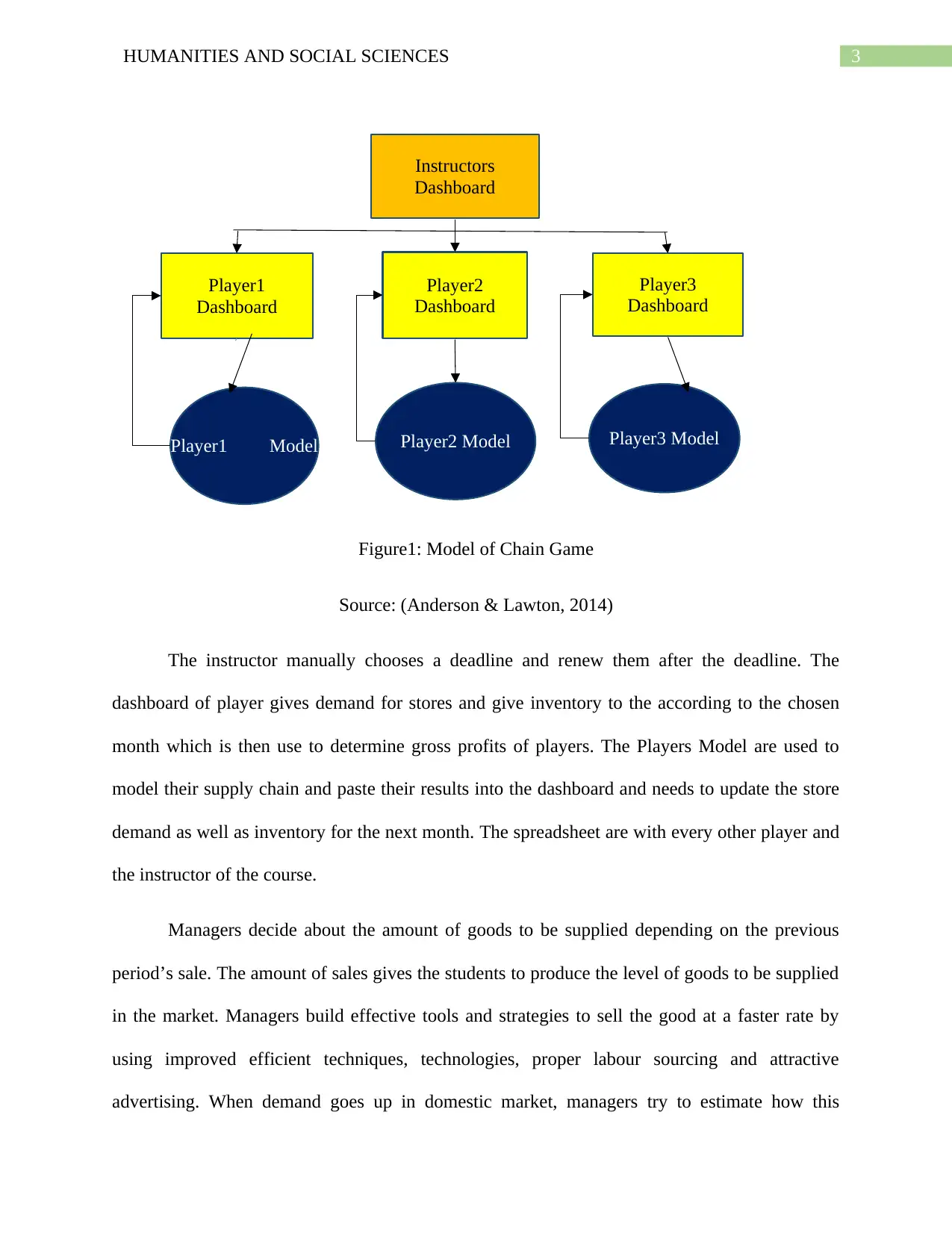
3HUMANITIES AND SOCIAL SCIENCES
Instructors
Dashboard
Player1
Dashboard
Player2
Dashboard
Player3
Dashboard
Player1 Model Player2 Model Player3 Model
Figure1: Model of Chain Game
Source: (Anderson & Lawton, 2014)
The instructor manually chooses a deadline and renew them after the deadline. The
dashboard of player gives demand for stores and give inventory to the according to the chosen
month which is then use to determine gross profits of players. The Players Model are used to
model their supply chain and paste their results into the dashboard and needs to update the store
demand as well as inventory for the next month. The spreadsheet are with every other player and
the instructor of the course.
Managers decide about the amount of goods to be supplied depending on the previous
period’s sale. The amount of sales gives the students to produce the level of goods to be supplied
in the market. Managers build effective tools and strategies to sell the good at a faster rate by
using improved efficient techniques, technologies, proper labour sourcing and attractive
advertising. When demand goes up in domestic market, managers try to estimate how this
Instructors
Dashboard
Player1
Dashboard
Player2
Dashboard
Player3
Dashboard
Player1 Model Player2 Model Player3 Model
Figure1: Model of Chain Game
Source: (Anderson & Lawton, 2014)
The instructor manually chooses a deadline and renew them after the deadline. The
dashboard of player gives demand for stores and give inventory to the according to the chosen
month which is then use to determine gross profits of players. The Players Model are used to
model their supply chain and paste their results into the dashboard and needs to update the store
demand as well as inventory for the next month. The spreadsheet are with every other player and
the instructor of the course.
Managers decide about the amount of goods to be supplied depending on the previous
period’s sale. The amount of sales gives the students to produce the level of goods to be supplied
in the market. Managers build effective tools and strategies to sell the good at a faster rate by
using improved efficient techniques, technologies, proper labour sourcing and attractive
advertising. When demand goes up in domestic market, managers try to estimate how this
Paraphrase This Document
Need a fresh take? Get an instant paraphrase of this document with our AI Paraphraser
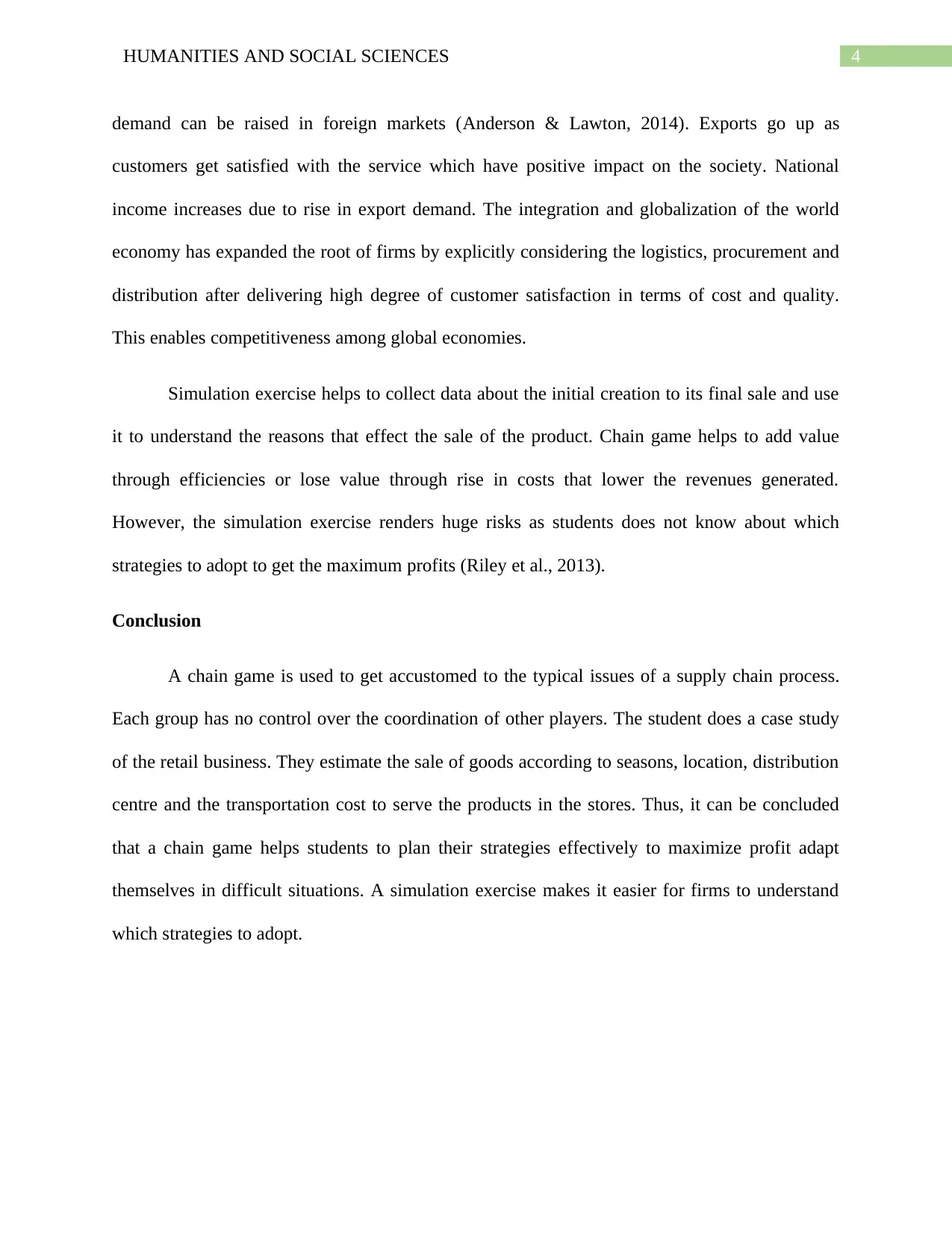
4HUMANITIES AND SOCIAL SCIENCES
demand can be raised in foreign markets (Anderson & Lawton, 2014). Exports go up as
customers get satisfied with the service which have positive impact on the society. National
income increases due to rise in export demand. The integration and globalization of the world
economy has expanded the root of firms by explicitly considering the logistics, procurement and
distribution after delivering high degree of customer satisfaction in terms of cost and quality.
This enables competitiveness among global economies.
Simulation exercise helps to collect data about the initial creation to its final sale and use
it to understand the reasons that effect the sale of the product. Chain game helps to add value
through efficiencies or lose value through rise in costs that lower the revenues generated.
However, the simulation exercise renders huge risks as students does not know about which
strategies to adopt to get the maximum profits (Riley et al., 2013).
Conclusion
A chain game is used to get accustomed to the typical issues of a supply chain process.
Each group has no control over the coordination of other players. The student does a case study
of the retail business. They estimate the sale of goods according to seasons, location, distribution
centre and the transportation cost to serve the products in the stores. Thus, it can be concluded
that a chain game helps students to plan their strategies effectively to maximize profit adapt
themselves in difficult situations. A simulation exercise makes it easier for firms to understand
which strategies to adopt.
demand can be raised in foreign markets (Anderson & Lawton, 2014). Exports go up as
customers get satisfied with the service which have positive impact on the society. National
income increases due to rise in export demand. The integration and globalization of the world
economy has expanded the root of firms by explicitly considering the logistics, procurement and
distribution after delivering high degree of customer satisfaction in terms of cost and quality.
This enables competitiveness among global economies.
Simulation exercise helps to collect data about the initial creation to its final sale and use
it to understand the reasons that effect the sale of the product. Chain game helps to add value
through efficiencies or lose value through rise in costs that lower the revenues generated.
However, the simulation exercise renders huge risks as students does not know about which
strategies to adopt to get the maximum profits (Riley et al., 2013).
Conclusion
A chain game is used to get accustomed to the typical issues of a supply chain process.
Each group has no control over the coordination of other players. The student does a case study
of the retail business. They estimate the sale of goods according to seasons, location, distribution
centre and the transportation cost to serve the products in the stores. Thus, it can be concluded
that a chain game helps students to plan their strategies effectively to maximize profit adapt
themselves in difficult situations. A simulation exercise makes it easier for firms to understand
which strategies to adopt.

5HUMANITIES AND SOCIAL SCIENCES
⊘ This is a preview!⊘
Do you want full access?
Subscribe today to unlock all pages.

Trusted by 1+ million students worldwide

6HUMANITIES AND SOCIAL SCIENCES
Reference List
Anderson, P. H., & Lawton, L. (2014, February). The effectiveness of a simulation exercise for
integrating problem-based learning in management education. In Developments in
Business Simulation and Experiential Learning: Proceedings of the Annual ABSEL
conference (Vol. 32).
Gómez-Cruz, N. A., Loaiza Saa, I., & Ortega Hurtado, F. F. (2017). Agent-based simulation in
management and organizational studies: a survey. European Journal of Management and
Business Economics, 26(3), 313-328.
Laguna, M., & Marklund, J. (2013). Business process modeling, simulation and design.
Chapman and Hall/CRC.
Riley Jr, R. A., Cadotte, E. R., Bonney, L., & MacGuire, C. (2013). Using a business simulation
to enhance accounting education. Issues in Accounting Education, 28(4), 801-822.
Song, J. S., & Yao, D. D. (Eds.). (2013). Supply chain structures: Coordination, information and
optimization (Vol. 42). Springer Science & Business Media.
Reference List
Anderson, P. H., & Lawton, L. (2014, February). The effectiveness of a simulation exercise for
integrating problem-based learning in management education. In Developments in
Business Simulation and Experiential Learning: Proceedings of the Annual ABSEL
conference (Vol. 32).
Gómez-Cruz, N. A., Loaiza Saa, I., & Ortega Hurtado, F. F. (2017). Agent-based simulation in
management and organizational studies: a survey. European Journal of Management and
Business Economics, 26(3), 313-328.
Laguna, M., & Marklund, J. (2013). Business process modeling, simulation and design.
Chapman and Hall/CRC.
Riley Jr, R. A., Cadotte, E. R., Bonney, L., & MacGuire, C. (2013). Using a business simulation
to enhance accounting education. Issues in Accounting Education, 28(4), 801-822.
Song, J. S., & Yao, D. D. (Eds.). (2013). Supply chain structures: Coordination, information and
optimization (Vol. 42). Springer Science & Business Media.
1 out of 7
Related Documents
Your All-in-One AI-Powered Toolkit for Academic Success.
+13062052269
info@desklib.com
Available 24*7 on WhatsApp / Email
![[object Object]](/_next/static/media/star-bottom.7253800d.svg)
Unlock your academic potential
Copyright © 2020–2025 A2Z Services. All Rights Reserved. Developed and managed by ZUCOL.





